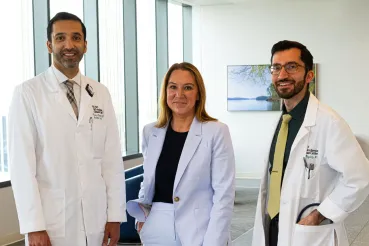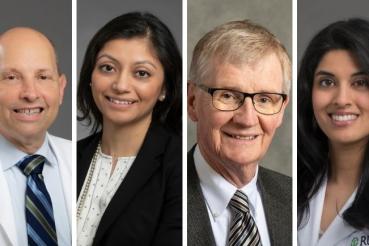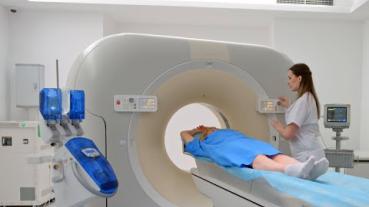We don’t often consider the role our lungs play in keeping us strong and well. It’s only when we experience breathing problems that we begin to appreciate how hard our lungs work for us. The truth is that, like the rest of our body, our lungs require daily care and attention to function at their best.
Breathing feeds oxygen to the cells throughout your body. Without sufficient oxygen, people are more prone to health problems, including respiratory illnesses, chronic obstructive pulmonary disease, and even heart disease.
But the ordinary breathing that we do day in and out isn’t enough to keep the oxygen flowing through the body at peak levels, according to experts at Rush.
"Lungs at rest and during most daily activities are only at 50 percent of their capacity," says Sujay Bangarulingam, MD, a Rush pulmonary medicine specialist who sees patients in Aurora. "Like the rest of your body, lungs thrive on movement and activity."
Since regular day-to-day activity doesn’t help you use your lungs to full capacity, you need to challenge the lungs with more intense activity.
“And to help counteract the buildup of toxins and tar in the lungs caused by environmental pollutants, allergens, dust and cigarette smoke, you need to help your lungs cleanse themselves,” Bangarulingam explains.
Follow these nine tips to help improve your lung health and keep these vital organs going strong for life:
1. Diaphragmatic breathing
Among the many things you can do to keep your lungs functioning properly are some simple breathing techniques, according to Mollie Brinkman, RRT, a pulmonary rehabilitation therapist at Rush Oak Park Hospital.
“These techniques can be used for people who are experiencing lung problems related to asthma, emphysema and chronic bronchitis, as well as healthy individuals,” Brinkman says.
Diaphragmatic breathing uses the awareness of the diaphragm muscle, which separates the organs in the abdomen from the lungs.
“By concentrating on lowering the diaphragm as you breathe in, you’ll get a much deeper inhale," Brinkman says. “This is the technique that professional singers use to increase their lung capacity.”
2. Simple deep breathing
Deep breathing can help you get closer to reaching your lungs’ full capacity.
As you slowly inhale, consciously expand your belly with awareness of lowering the diaphragm. Next, expand your ribs, allowing them to float open like wings. Finally, allow the upper chest to expand and lift.
Then exhale as completely as possible by letting the chest fall, and then contracting the ribs and, finally, bringing your stomach muscles in and up to lift the diaphragm and expel the last bit of air.
3. 'Counting' your breaths
You can also increase your lung capacity by increasing the length of your inhalations and exhalations. Start by counting how long a natural breath takes. If it takes to the count of five to inhale, it should take to the count of five to exhale. Try to keep them to an equal length.
Once you’ve discovered the count for your average breath, add one more count to each inhale and exhale until you can comfortably extend the length of time it takes to fill and empty your lungs.
The idea is to avoid straining or causing discomfort — it should be a gradual and easy process.
4. Watching your posture
Since the lungs are soft structures, they only take up the room that you make for them.
“You want to occasionally sit tall and reach overhead to make more room for your lungs,” Bangarulingam says. “A simple technique for giving your lungs even more room is leaning back slightly in a stable chair, lifting the chest and opening the front of your body as you breathe deeply."
5. Staying hydrated
Getting enough water is as important for the lungs as it is for the rest of the body.
“Staying well hydrated by taking in fluids throughout the day helps keep the mucosal linings in the lungs thin,” Bangarulingam says. “This thinner lining helps the lungs function better.”
6. Laughing
“Laughing is a great exercise to work the abdominal muscles and increase lung capacity,” Bangarulingam says. “It also clears out your lungs by forcing enough stale air out that allows fresh air to enter into more areas of the lung.”
7. Staying active
“Regular, moderately intense activity is great for the lungs, and when you increase your daily activity you get three things done at once: healthy lungs, a healthier heart and a better mood,” Bangarulingam says.
Aim for at least 20 minutes of consistent, moderately intense movement daily, like a brisk walk or a bike ride.
8. Joining a breathing club
“If you can’t be active because of lung problems, you can join a breathing club,” Brinkman says.
These are support groups for people with lung and breathing problems. You can work on breathing techniques and get encouragement and information to help keep you healthy and improve your quality of life.
The American Lung Association offers Better Breathers Clubs throughout Illinois and around the country. Visit the American Lung Association website or call (800) LUNG-USA (586-4872) to find one near you.
9. Pulmonary rehabilitation
For those with chronic lung disease such as asthma, post-COVID-19 lung disease, or lung cancer, a pulmonary rehabilitation program can help you return to a more active lifestyle. You can find a program close to you — the Rush Oak Park Hospital Pulmonary Rehabilitation Program in Oak Park or the Rush Copley Pulmonary Rehabilitation Program in Aurora.
With pulmonary rehabilitation, you will engage in a personalized 10- to 12-week course of exercise, education, counseling and support designed to help you regain your physical strength and stamina as well as address emotional barriers to your health and well being.
To learn more or schedule an appointment, please call (708) 660-5864.
The doctor will see you now
If your lungs are damaged or you have a serious illness like COPD or lung cancer, you may experience one or more of the following symptoms:
- Shortness of breath during simple activities
- Pain when breathing
- Dizziness with a change in activity
- A persistent cough
- Wheezing with exercise
- Cough associated with exercising
- Pain in the airway (the path that air follows to get into and out of the lungs)
See your primary care doctor if you have any of these symptoms. They can run tests to figure out the cause or refer you to a specialist if needed.
If you have a history of smoking, talk to your doctor about how often you should have your lungs checked. The good news is that if you stop smoking, you can recover from the damage and track your progress during checkups.




